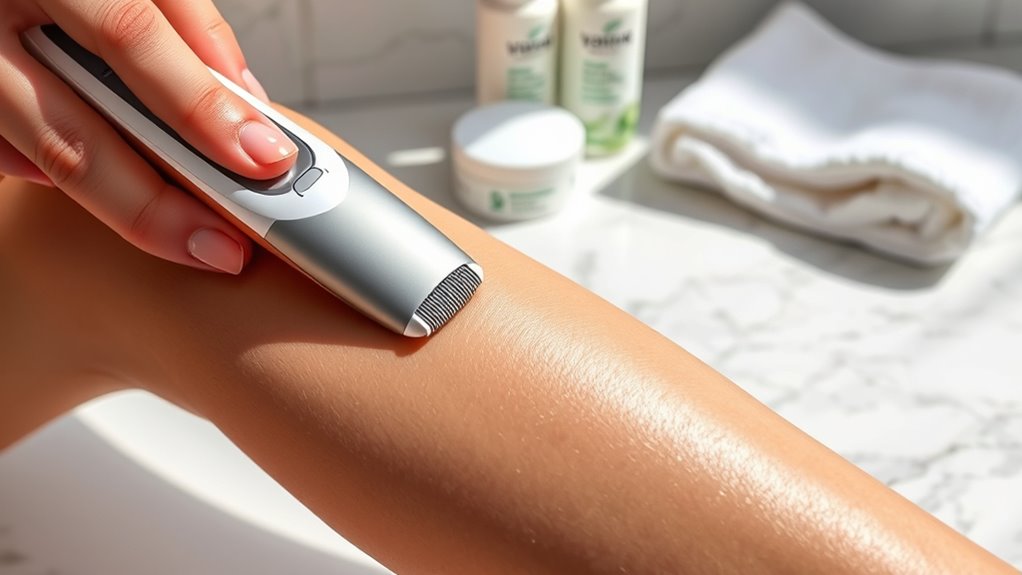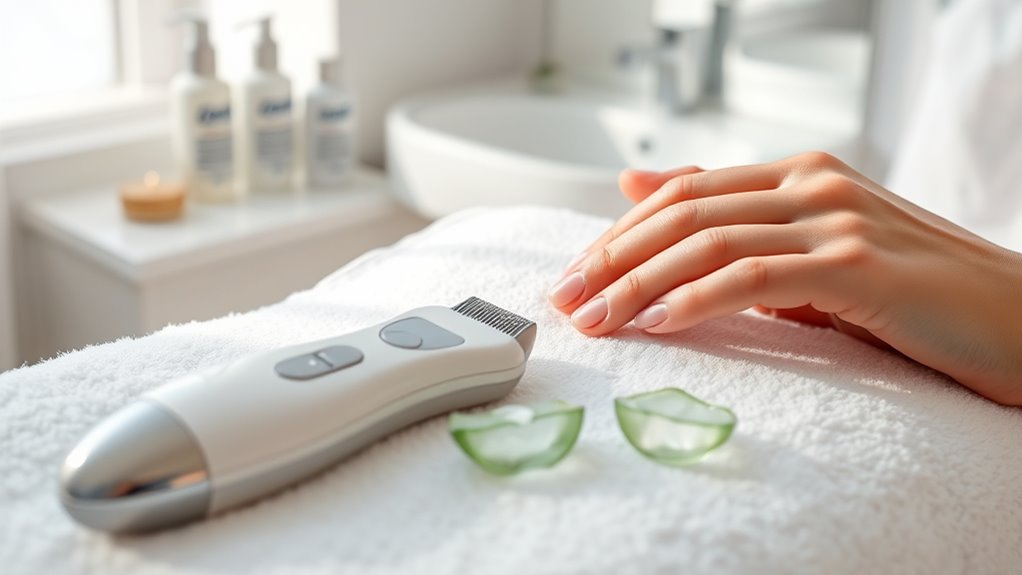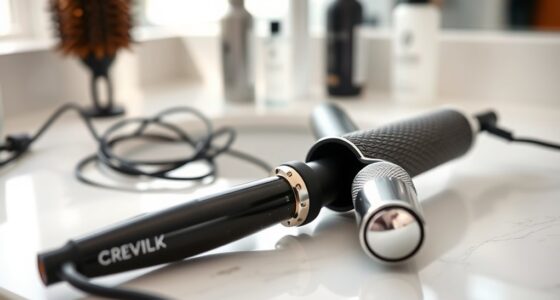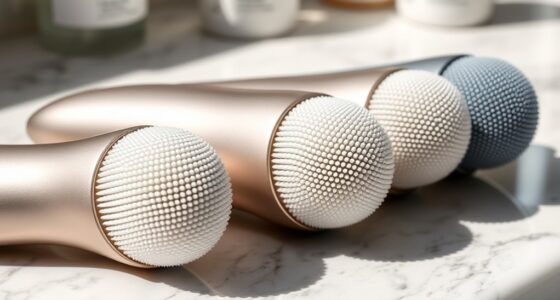To get the best results, hold your skin taut and move the epilator slowly against hair growth, starting at a low speed to reduce discomfort. Before you begin, exfoliate your skin and make sure it’s dry and clean; consider pain relievers or numbing creams if needed. After epilation, soothe your skin with aloe vera or fragrance-free moisturizer and avoid harsh products or heat. Proper technique and aftercare can make your experience more comfortable; discover tips to improve your routine next.
Key Takeaways
- Hold skin taut and move the epilator slowly against hair growth for effective, less painful results.
- Exfoliate beforehand and moisturize afterward to prevent ingrown hairs and soothe skin.
- Start with lower speed settings and consider numbing creams or pain relievers for sensitive areas.
- Avoid hot showers, tight clothing, and harsh products immediately after epilation to reduce irritation.
- Regularly exfoliate and follow proper techniques to improve comfort and achieve long-lasting smoothness.

Are you tired of frequent shaving or waxing sessions? If so, epilators might be a game-changer for you. They remove hair from the root, providing longer-lasting smoothness, but it’s essential to understand the technique and aftercare to make the experience as comfortable as possible. When using an epilator, especially if you have sensitive skin, you need to prioritize skin sensitivity and pain management. Sensitive skin can react more intensely to epilation, causing redness, irritation, or even small bumps. To minimize discomfort, start by exfoliating your skin a day or two before epilation. This helps remove dead skin cells and reduces the chances of ingrown hairs. Also, choosing the right epilator with multiple speed settings allows you to start at a lower speed, which can help ease pain, especially if you’re new to epilation.
Before you begin, ensure your skin is clean and completely dry. Wet or damp skin can make the process more uncomfortable and reduce the effectiveness of hair removal. If you experience high pain levels, taking an over-the-counter pain reliever about 30 minutes beforehand can help manage discomfort. Some people also find that applying a numbing cream to sensitive areas can be beneficial, but always follow the instructions carefully. When you start epilating, hold your skin taut to reduce pulling and lessen pain. Move the epilator slowly against the direction of hair growth for better results and less irritation. Remember, patience is key—don’t rush the process, especially if you’re working on sensitive areas. You might notice some redness or irritation afterward, which is normal, but applying a soothing, fragrance-free moisturizer or aloe vera gel can help calm your skin. Additionally, choosing an epilator designed with hydrocolloid technology can improve comfort and reduce skin irritation during hair removal.
Post-epilation care is just as important as the technique itself. Avoid hot showers, saunas, or intense workouts for at least 24 hours, as heat can exacerbate irritation. Wear loose clothing to prevent friction on sensitive skin. To prevent ingrown hairs, continue exfoliating regularly in the days following epilation. If you experience prolonged redness, swelling, or pain, consider applying an over-the-counter hydrocortisone cream or consulting a dermatologist. Keep your skin moisturized and avoid harsh chemicals or perfumes that can cause further irritation. With consistent practice and proper aftercare, epilation can become a more tolerable and effective hair removal method, giving you smooth skin that lasts longer than shaving or waxing. Remember, understanding your skin’s sensitivity and managing pain effectively can turn epilation into a much more comfortable experience.
Frequently Asked Questions
Can Epilators Be Used on Sensitive Skin Areas Safely?
Yes, you can use epilators on sensitive skin areas safely if you follow proper epilator safety tips. Before using, make certain your skin is clean and dry, and consider doing a patch test first. Use the epilator gently and avoid pressing too hard. If you experience irritation, limit use or try soothing creams afterward. Always read your epilator’s instructions to prevent skin irritation and maintain safe, effective hair removal.
How Often Should I Replace the Epilator Heads?
You should replace your epilator heads every 12 to 18 months to maintain peak performance. Imagine the tiny teeth or tweezers gradually dulling, reducing efficiency and increasing discomfort. Regular head maintenance ensures smooth results and prevents skin irritation. Keep an eye out for signs like pulling or less effective hair removal, and don’t delay replacing the head—your skin deserves the best care. Staying on schedule guarantees safe, effective epilation every time.
Is It Normal to Experience Ingrown Hairs After Epilation?
It’s normal to experience ingrown hairs after epilation, especially if your skin is sensitive or if you haven’t exfoliated regularly. These ingrown hairs can cause skin irritation and discomfort. To minimize this, keep your skin moisturized, exfoliate gently before and after epilation, and avoid tight clothing. If ingrown hairs persist or worsen, consult a dermatologist for tailored advice and treatment options.
Are There Specific Epilators Recommended for Beginners?
You’ll want to start with a beginner-friendly epilator, as it makes the process safe and comfortable. Look for models with gentle tweezers and adjustable speed settings—these are your best bet for a smooth experience. Many brands offer safe options designed specifically for beginners, so don’t hesitate to choose one that’s labeled as beginner-friendly. This way, you’ll enjoy a less intimidating, more effective epilation journey.
Can Epilating Cause Skin Discoloration or Hyperpigmentation?
Epilating can cause skin discoloration or hyperpigmentation, especially if you’re prone to it or have sensitive skin. You might notice darker patches after frequent use or if you don’t follow proper aftercare. To minimize risks, avoid sun exposure, use soothing lotions, and don’t overdo it. If discoloration persists, consider consulting a dermatologist. Proper technique and skin care are key to preventing hyperpigmentation from epilating.
Conclusion
So, you’ve mastered the art of epilating—painful, precise, and surprisingly satisfying. Who knew that enduring the discomfort would leave your skin smoother than ever? Irony of ironies, the very process that tests your patience now rewards you with hair-free confidence. Next time you wince at the pain, remember: it’s a small price to pay for the luxury of ditching razors forever. After all, beauty often demands a little suffering, doesn’t it?








